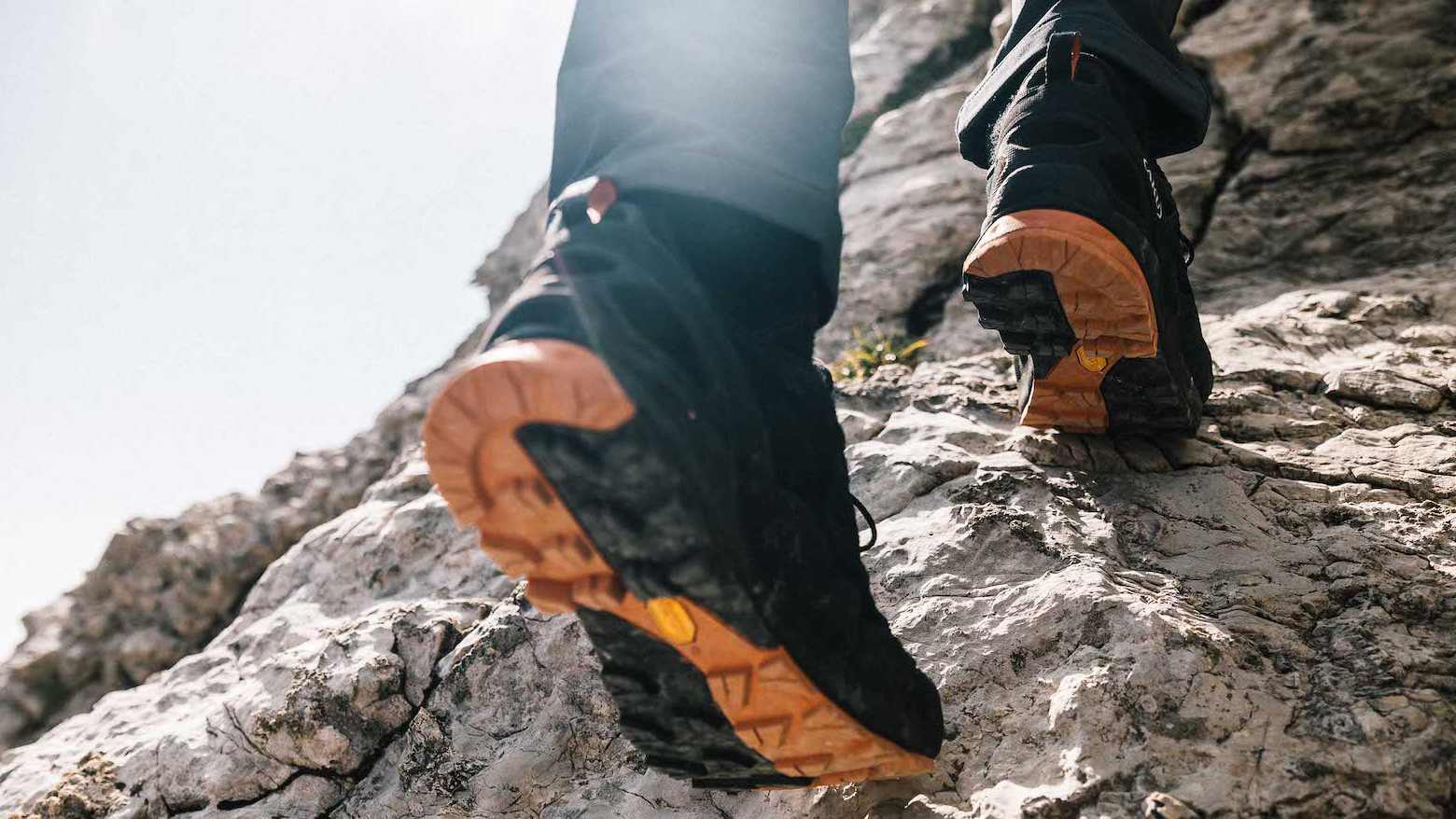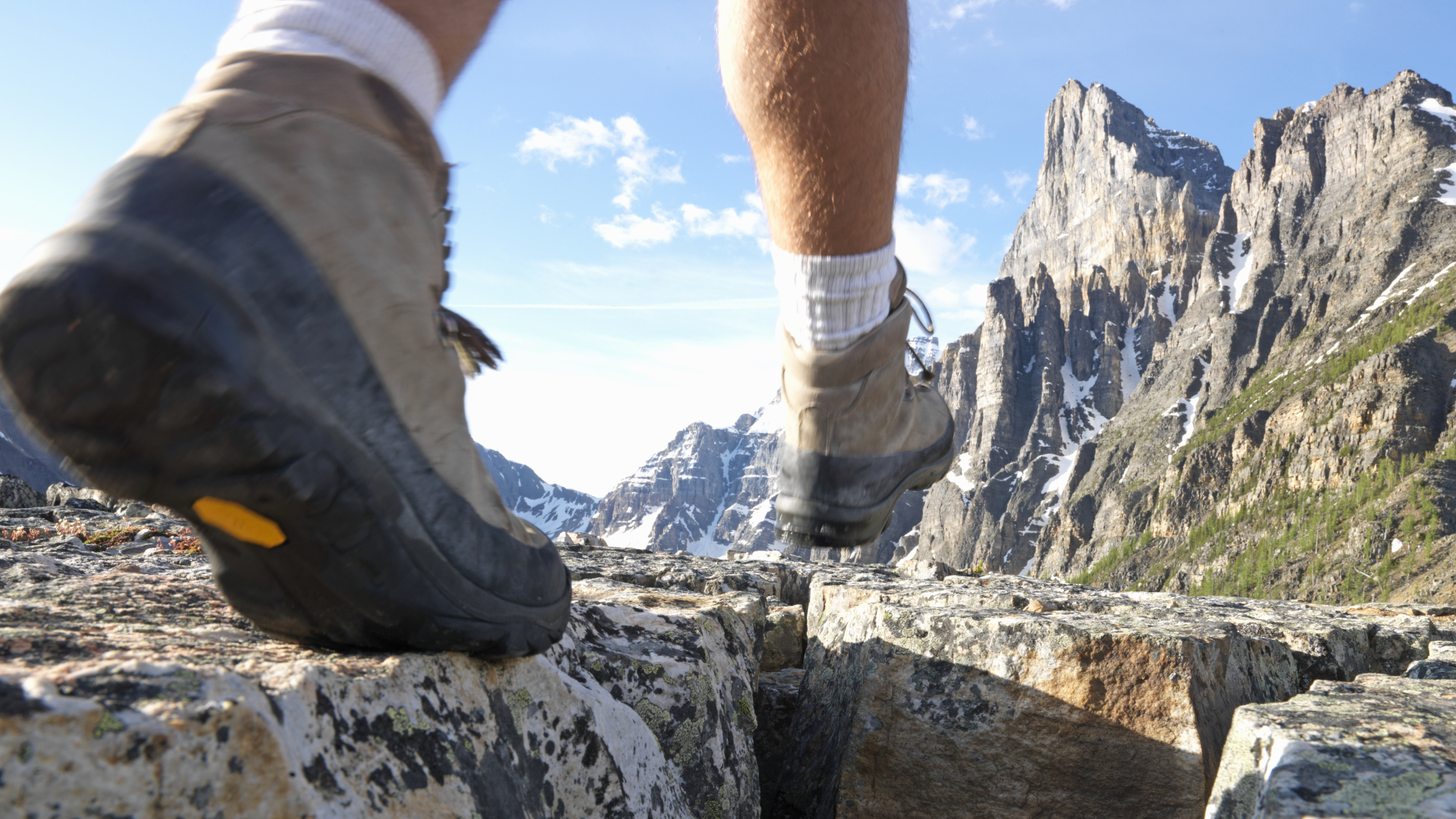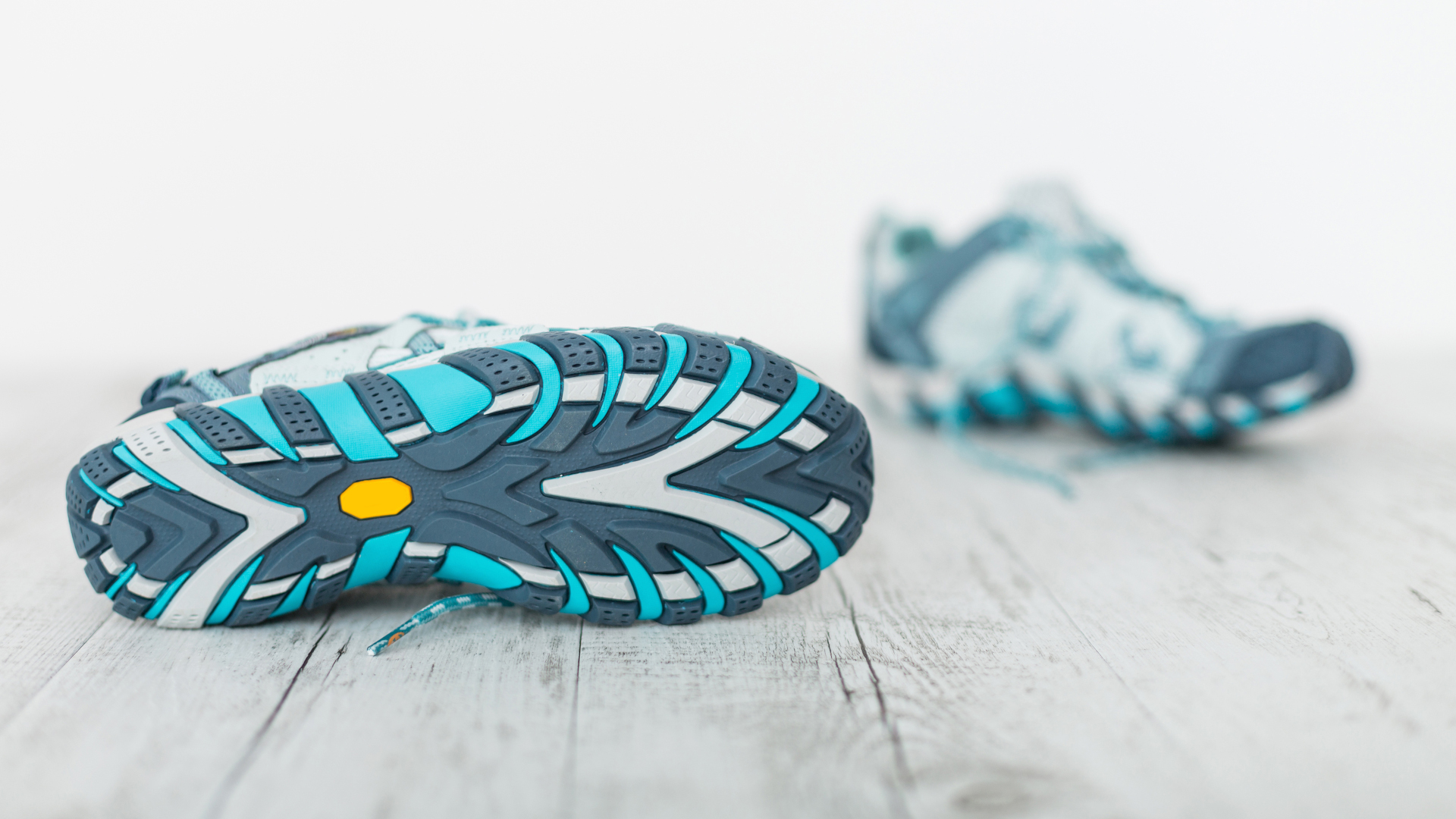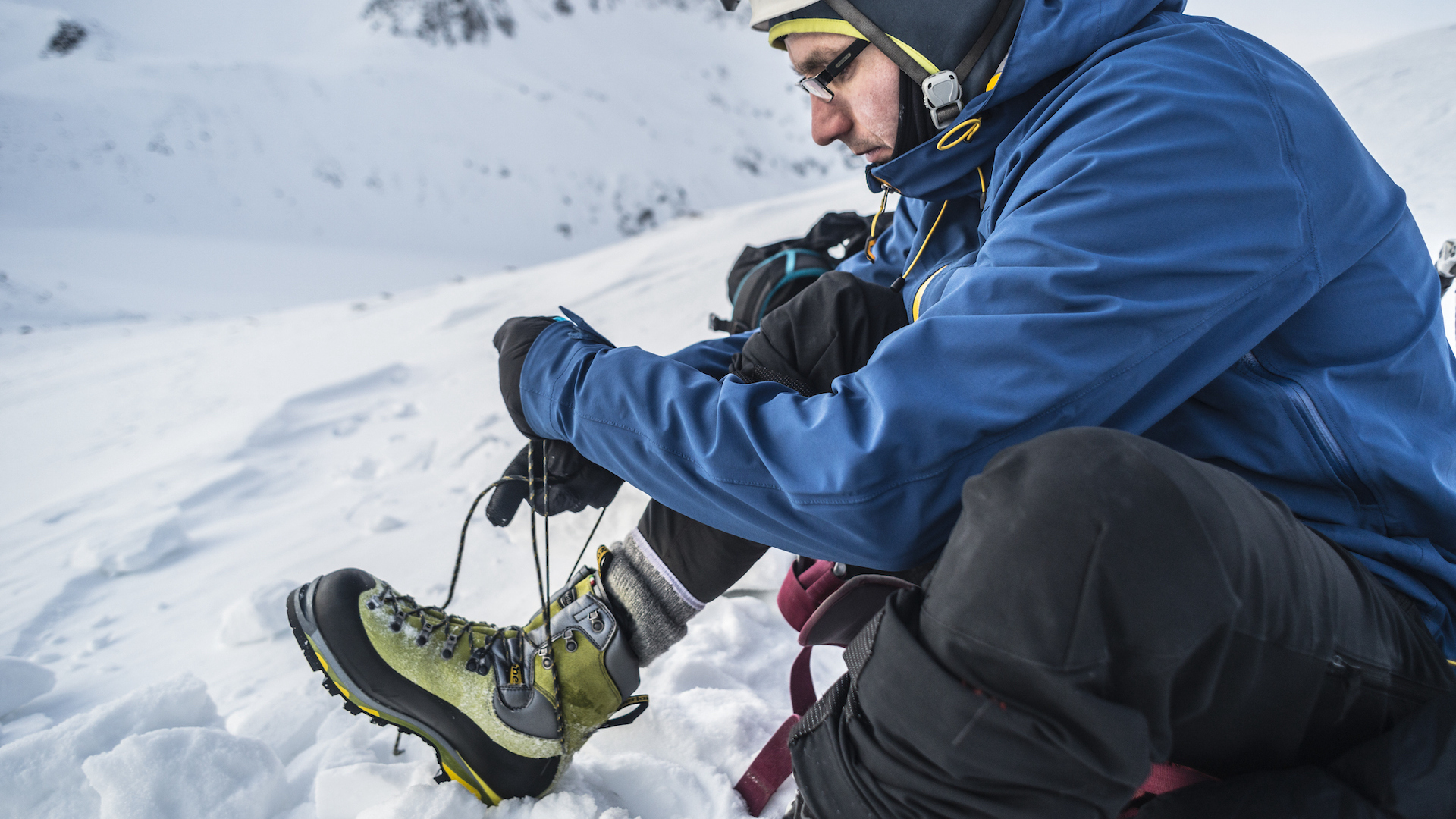
Turn over your favourite hiking boot or trail running shoe and you are likely to see one of a handful of brands named on the sole. They are likely to include Vibram, Michelin, Continental, so own-brands such as those made my inov8 and Keen.
These brands use rubber, derived from tropical plants, or natural gas and petroleum, to form a durable, elastic and grippy surface on the base of outdoors footwear. Some add their own extra ingredients, such as invo8's graphene.
However, the most commonly used brand for outsoles on hiking footwear and many trail running shoes is Vibram. In fact, the majority of boots in our best hiking boots guide are designed with a Vibram sole.
But, what is a Vibram sole exactly? We take a look at the history and features of this legendary product of outdoor footwear, and explain why you might want to choose it.
What is a Vibram sole?
Vibram (pronounced “vee-bram”) is a brand of shoe sole produced and licensed by an Italian company of the same name. The brand use rubber compounds to produce outsoles that are fit for the exacting demands of trail runners, hikers and mountaineers.
Vibram's founder, Vitale Bramani, claims to be the first in the world to design a rubber lug outsole, which was motivated by his desire to improve mountaineering footwear. Today, Vibram is a mainstay in the outdoor footwear industry.
The history of Vibram
- Vibram was founded by Italian mountaineer Vitale Bramani
- He patented the first rubber lug sole in the 1950s
- The first ascent of K2 in 1954 was achieved by an Italian team using Vibram soles
Vibram was named after its founder, a mountaineer called Vitale Bramani. Vibram combines the first two letters of his first name and the first four letters of his surname.
Bramani lost six friends in a mountaineering accident in 1935 and he blamed their deaths on inadequate footwear. At the time, climbing footwear had either a leather sole fitted with hobnails, or a felt sole which offered good tread except when frozen, as is often the case in the Italian Alps.

In response to the tragedy, Bramani engineered the first rubber lug sole, which is essentially a rubber sole with deep tread like you see on a tractor or tank tire (he named the design “carrarmato” which is Italian for tank).
Two years later, he patented the design and it soon became the go-to sole in mountaineering gear. In fact, in 1954, the controversial first ascent of K2 was made by an Italian climbing team wearing boots with Vibram soles.
The soles were initially used for mountaineering boots but now you see them on everything from hiking boots to running shoes to the best water shoes. Today, the company reports that more than 1,000 shoemakers use their soles in production with more than 35 million soles produced worldwide each year.
Along with the likes of Gore-Tex, it's the additional logo you're most likely to see on many footwear brands' products, from giants such as Nike and Merrell, to specialist mountaineering and trekking brands, including fellow Italian manufacturers Scarpa and Aku.
The latter even released a limited edition Conero GTX hiking boot colored completely in Vibram's eye-catching yellow, celebrating their ongoing partnership. We learned all about the respect Aku have for Vibram's products when one of our testers was invited inside their Italian hiking boot factory to discover more about how hiking boots are made.

Is Vibram better than rubber?
- Vibram soles are made from rubber compounds
- The brand treats the rubber to achieve the desired qualities
Vibram soles are made of rubber, but it’s not just any rubber. The company uses rubber compounds, which means they treat the rubber to harden or soften it according to its use.
For example, mountaineering boots are made with vulcanized rubber, which means the rubber that has been hardened to withstand extreme conditions such as rocky trails and freezing temperatures, whereas climbing shoes will have Vibram soles made of rubber treated to make it more pliable for scaling rock faces.

Different types of Vibram soles
In the last 85 years, Vibram has branched out significantly. They make soles for all kinds of shoes, from recreational outdoors footwear to work shoes. There are five main categories of Vibram sole with different purposes:
- Grip: these include soles for boots made for hiking.
- Lightweight: these include soles for shoes made for everyday wear and running.
- Climbing: this special line includes soles with the flexibility needed for climbing.
- Safety: the soles are designed for working boots and shoes in harsh conditions.
- Flame resistant: the soles withstand extreme heat and are used by firefighters and other emergency workers.
Each of these categories has many different types of sub-sole to cater for specialized purposes. For example, Aku's Trekker Lite III GTX features a Vibram Curcuma outsole, which offers great stability and precision on hikes, approach walks and steep, technical terrain. Whereas Vibram Megagrip – featured on the likes of Scarpa's Crux approach shoe, Danner's Trail 2650 Campo GTX hiking shoe and Aku's Rock DFS GTX hybrid approach shoe – is a compound that provides solid grip on both wet and dry ground.
When it comes to trail running, many brands use Vibram for grip on wet and rocky trails. For example, Hoka's Speedgoat 6 trail running shoes have Vibram outsoles.

What are the advantages of Vibram soles?
There's a reason why these soles have become iconic in the footwear world. If you are looking at a pair of hiking shoes with Vibram soles, there are six main advantages you can expect from them:
- Traction: rubber is a great non-slip material and all Vibram soles have tread. The deeper the tread, the more traction you can expect.
- Comfort: rubber is a flexible material, meaning in addition to cushioning, it flexes with your feet and also takes less time to break in.
- Waterproof: Vibram soles keep the water out, so you can hike in rainy and boggy conditions without getting wet feet and painful boot rub.
- Durability: Vibram soles are known for being especially long-lasting against wear and tear, meaning even if you like to hike a lot you can expect to get years out of your boots. And when you do wear yours out, you can get them resoled to save you money and the pain of having to break in a whole new pair.
- Easy to clean: some Vibram soles are essentially self cleaning with deep tread that sheds dirt when you flex your foot in walking, while all are machine washable (you’ll still want to check your shoes for washing instructions before throwing them in the machine, though).
- Sustainable production: Vibram certainly produces a lot of soles, but they also have a Sustainable Way commitment that details their impact on the climate.







